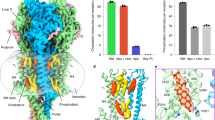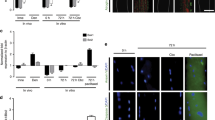Abstract
Curare has long been regarded as a typical competitive antagonist of acetylcholine (ACh) at the vertebrate neuromuscular junction. Recently, however, it has been shown that curare can also block the channels opened by ACh at the frog neuromuscular junction as well as on rat and Aplysia neurons1–4; moreover, curare is able to depolarize rat myotubes and thus behaves as an agonist for the cholinergic receptor of this preparation5 (see ref. 6). Using the single channel recording technique7,8, we have now found that, on rat myotubes, curare can both open and block in the same cell the channels controlled by the cholinergic receptor.
Similar content being viewed by others
References
Manalis, R. Nature 267, 366–368 (1977).
Katz, B. & Miledi, R. Proc. R. Soc. B203, 119–133 (1978).
Colquhoun, D., Dreyer, F. & Sheridan, R. J. J. Physiol., Lond. 293, 247–284 (1979).
Marty, A., Neild, T. O. & Ascher, P. Nature 261, 501–503 (1976); J. Physiol., Lond. 278, 207–235 (1978).
Ziskind, L. & Dennis, M. Nature 276, 622–623 (1978).
Morris, C., Jackson, M., Lecar, H. & Wong, S. Biophys. J. 37, 19a (1982).
Neher, E. & Sakmann, B. Nature 260, 799–802 (1976).
Hamill, O., Marty, A., Neher, E., Sakmann, B. & Sigworth, F. Pflügers Arch. ges. Physiol. 391, 85–100 (1981).
Hamill, O. & Sakmann, B. Nature 294, 462–464 (1981).
Colquhoun, D. & Sakmann, B. Nature 294, 464–466 (1981).
Sakmann, B., Patlak, J. & Neher, E. Nature 286, 71–73 (1980).
Colquhoun, D. & Hawkes, A. Proc. R. Soc. B199, 231–262 (1977).
Ascher, P., Large, W. & Rang, H. J. Physiol., Lond. 295, 139–170 (1979).
Adams, P. R. J. Physiol., Lond. 260, 531–552 (1976).
Magleby, K. & Stevens, C. J. Physiol., Lond. 223, 173–197 (1972).
Adams, P. R. J. Physiol., Lond. 268, 291–318 (1977).
Neher, E. & Steinbach, J. H. J. Physiol., Lond. 277, 153–176 (1978).
Fischbach, G. & Cohen, S. Devl Biol. 31, 147–162 (1973).
Neubig, R. & Cohen, J. Biochemistry 24, 5464–5475 (1979).
Adams, P. R. & Sakmann, B. Proc. natn. Acad. Sci. U.S.A. 75, 2994–2998 (1978).
Michler, A. & Sakmann, B. Devl Biol. 80, 1–17 (1980).
Fischbach, G. & Schuetze, S. J. Physiol., Lond. 303, 125–137 (1980).
Dennis, M., Ziskind-Conhaim, L. & Harris, A. Devl Biol. 81, 266–279 (1981).
Author information
Authors and Affiliations
Rights and permissions
About this article
Cite this article
Trautmann, A. Curare can open and block ionic channels associated with cholinergic receptors. Nature 298, 272–275 (1982). https://doi.org/10.1038/298272a0
Received:
Accepted:
Issue Date:
DOI: https://doi.org/10.1038/298272a0
- Springer Nature Limited
This article is cited by
-
Myasthenia gravis as a prototype autoimmune receptor disease
Immunologic Research (1997)
-
1. Antibodies with N-choline receptor recognition characteristics immunochemical modeling of ligand-receptor reactions
Pharmaceutical Chemistry Journal (1992)
-
Immunochemical modeling of ligand-receptor interactions. IV. Antibodies that recognize antidepolarizing myorelaxants
Pharmaceutical Chemistry Journal (1992)
-
Receptor-mediated presynaptic facilitation of quantal release of acetylcholine induced by pralidoxime inAplysia
Cellular and Molecular Neurobiology (1990)
-
Mechanisms of tubocurarine action on nicotinic cholinoreceptors of rat sympathetic ganglia neurons
Neurophysiology (1988)





